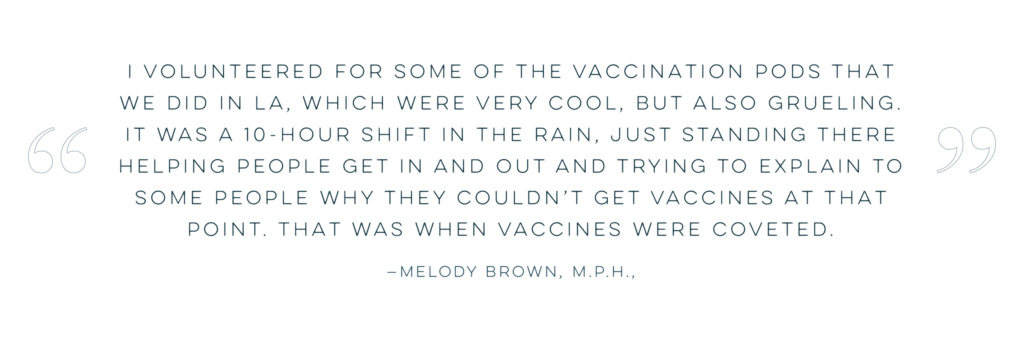“We are called to build a movement to mend the social fabric of our nation,” says Surgeon General Vivek Murthy in a 2023 advisory titled “Our Epidemic of Loneliness and Isolation.” In today’s fragmented and often oppositional culture, this prescription can sound at once inspirational and hard to envision. Although our lives are more interconnected than ever, we are also enduring currents that pull us apart, fissures in contemporary society that test our interactions and bonds with others.
No one understands this better than the public health workers who are tasked with addressing epidemics, experiencing up close the friction against any collective response taken on behalf of perceived public good. They have been at the forefront of creating connections in our far-flung and fractious society.

A community-sized challenge
“When it comes to the intersection between public health and loneliness, the challenge is to find ways to identify the people who are experiencing loneliness, as we would do with any mental health issue,” says Marianne Jankowski, D.H.Sc., chair of the Master of Public Health program at The Chicago School.
The surgeon general’s advisory draws a distinction between the subjective feeling of loneliness and a lack of social connection, which is easier to quantify yet tricky to measure because not all social interactions are alike. The report identifies three vital components of social interaction:
- Structure, or the number and types of relationships and how frequently interactions occur.
- Function, which describes how well a person’s relationships meet their needs.
- Quality, determined by the degree to which relationships are positive or negative.
A growing number of people are falling short of a healthy range of interpersonal contact, suggesting the need for a public role in expanding connections. Dr. Jankowski points to Melody Brown and Simone Veum, two recent graduates of her program who are working to mitigate health epidemics in their communities as possible models for this approach, one at the county level and one in the medical center of major research university.

Melody Brown, M.P.H., a graduate of The Chicago School and the data science and systems teams manager for acute communicable disease control for the Los Angeles County Department of Public Health, began working for the agency in November 2020. This was perhaps the most challenging time for public health workers in the last century. At the height of the pandemic, Brown helped build a new disease surveillance system for the county. She had a front-row seat as the systems were developed and applied in real life settings by a public health department.
“It was a really interesting experience to see everything in action trying to determine what the data was showing us,” she says, while acknowledging the unique challenges of carrying out this work as in a time of historic social disruption. “It was even more interesting because LA went with strict social distancing, closing down places and enforcing masking while I was living in Orange County where there was a very strong resistance to masking and to any kind of intervention.”
As a clinical research coordinator at the Masonic Cancer Center at the University of Minnesota, The Chicago School alumna Simone Veum, MPH, works directly with patients as well as physicians and nurses. Through this work, she has seen the effects of isolation on a patient’s course of treatment. Veum’s organization evaluated disparity of care for factors including location, age, income, and race. They found disparities along racial lines, particularly among Native Americans, as well as in residents of the state’s rural areas.
“With that work, we saw the bigger disparities that we have in race, socioeconomic status, and location just because trials were not available in these rural areas,” Veum says, adding that the people in those communities “are not getting the same types of assistance as people in metro areas.” Loneliness and isolation therefore can become complicating factors in any number of already complex diseases.

The role of public health
When it comes to the role of public health officials in addressing the loneliness epidemic, the surgeon general proposes five pillars to advance social connection:
- Establish social connection as a priority health indicator and social determinant of health with the goal of improving health and well-being through programs, education, research, and promotion of healthy lifestyles across the lifespan.
- Integrate social connection as a key component of health promotion and wellness programs focused on related health issues (e.g., suicide, workplace burnout, substance use).
- Study and support research on the causes of social disconnection.
- Evaluate, develop, and implement sustainable interventions and strategies across the social-ecological model to promote greater connection and prevent social disconnection.
- Consistently and regularly track social connection using validated metrics and validate new measures to capture the full complexity of social connection to guide strategic decision-making, planning, and evaluation of strategies.
These guidelines represent a mix of remedies, including infrastructure to encourage interaction, policies that mitigate the harm done by social disconnection, and mobilization of the public health sector. In essence, the surgeon general is proposing a massive public works project devoted to connecting the American populace, and public health officials will play an vital role.

In addressing loneliness as an epidemic, Dr. Jankowski says one of the first questions the answer is on what scale to address the problem. The second question is, “How would you begin creating a strategy within the type of work that you do within your program?” This is where identifying need is more difficult with a social condition than with a physical illness, such as cancer or COVID-19.
In a recent article for the American Medical Association, Peter A. Hollmann, MD, head of Brown Medicine, proposes this test: “Think about how someone might be isolated or lonely and what you may be able to do about it. Ask them what they think might be helpful and acceptable to them, and then advocate for resources in the community.”
The challenge for public health workers is to apply commonsense directives such as this in a public setting, including a municipality or a county. “We’re trained to think of it from a systemic aspect,” says Brown. “We ask what in the environment is fostering those feelings of loneliness, and from that information, we determine what are the interventions that we could potentially implement or changes that we could make to address the root causes of those problems.”
Public health employs all available avenues that connect individuals, as the work of public health workers depends on human contact within communities of need. As Veum describes the advantages of being able to see patients in person, particularly for those who may be getting difficult news about their treatment or prognosis, she illustrates the complicated realities of social interaction. “Our whole clinic is cancer patients,” Veum says. “When they come in, they see other people who are going through the same thing. You don’t feel as alone if you’re physically there.”
At the same time, telehealth provides a lifeline to socially isolated patients. “We have a lot of patients who are single individuals who have no spouses or family nearby and don’t live in the Minneapolis area; maybe they live two hours north,” she says. “We rely on a lot of different resources to ensure that individuals in rural areas are a part of the research process and get the support they need. Working with the doctors who are doing outreach to different areas around Minnesota to make ties with community leaders has been interesting and poignant,” Veum says.
The essential quality of human connection
The idea that we can be lonelier than ever at a time when we are more connected than ever highlights the challenge of curing social isolation. In the age of hyperconnectivity, many factors undermine the quality of social contact, including increased superficiality of interactions and reduced frequency of face-to-face interaction. In this environment, public health workers can play an important role in facilitating connections. “As public health practitioners, you have to provide a platform for people to feel safe, for people to discuss, as in any type of group interaction or social interaction, what’s going on,” Dr. Jankowski says. “Public health practitioners provide a platform for people to feel safe, accepted, and heard.”

